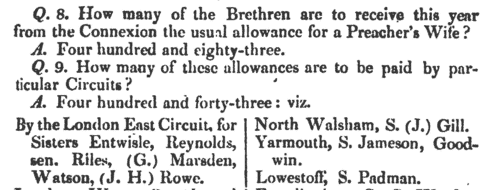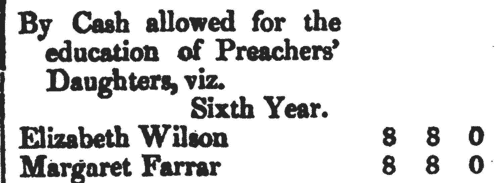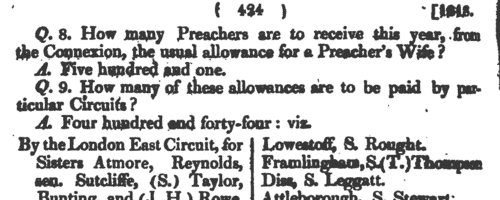Our indexes include entries for the spelling ogilvie. In the period you have requested, we have the following 555 records (displaying 201 to 210):
Daughters of Wesleyan Methodist preachers
(1816-1817)
Children of Wesleyan Methodist preachers could be educated by the church at their schools at Kingswood and Woodhouse Grove. For each girl not educated at these schools 8 guineas was allowed by the church to her father; these sums are listed in the annual accounts, with the girl's full name, arranged by school year, giving us an idea of her age. | Sample scan, click to enlarge

|
Wesleyan Methodist preachers' travel expenses
(1816-1817)
Major expenses incurred by Wesleyan Methodist preachers and reimbursed by the church are detailed in the annual accounts. The great majority of these expenses are the costs of moving to and between circuits, and give an indication of where a preacher has come from. There are also some items relating to serious illnesses and funerals. | Sample scan, click to enlarge

|
Wesleyan Methodist preachers' wives
(1816-1817)
Wives of Wesleyan Methodist ministers were supported by the church, either centrally or through the local congregations: lists of wives were therefore printed in the annual minutes. Unfortunately, the ladies' Christian names are never given; where it is necessary to distinguish between wives of ministers with the same surnames, the husbands' Christian names are given. The S. preceding each name signifies 'Sister'. Examining these lists is nevertheless a good way to trace approximate dates of marriage for a minister, and approximate dates of death of wives that predeceased them. | Sample scan, click to enlarge

|
Wesleyan Methodist preachers
(1817)
A comprehensive list of Wesleyan Methodist ministers arranged by station and circuit in Britain, Ireland and abroad, was prepared each year at the church's annual conference. This includes supernumeraries and missionary preachers. | Sample scan, click to enlarge

|
Daughters of Wesleyan Methodist preachers
(1817-1818)
Children of Wesleyan Methodist preachers could be educated by the church at their schools at Kingswood and Woodhouse Grove. For each girl not educated at these schools 8 guineas was allowed by the church to her father; these sums are listed in the annual accounts, with the girl's full name, arranged by school year, giving us an idea of her age. | Sample scan, click to enlarge

|
Wesleyan Methodist preachers' travel expenses
(1817-1818)
Major expenses incurred by Wesleyan Methodist preachers and reimbursed by the church are detailed in the annual accounts. The great majority of these expenses are the costs of moving to and between circuits, and give an indication of where a preacher has come from. There are also some items relating to serious illnesses and funerals. | Sample scan, click to enlarge

|
Wesleyan Methodist preachers' wives
(1817-1818)
Wives of Wesleyan Methodist ministers were supported by the church, either centrally or through the local congregations: lists of wives were therefore printed in the annual minutes. Unfortunately, the ladies' Christian names are never given; where it is necessary to distinguish between wives of ministers with the same surnames, the husbands' Christian names are given. The S. preceding each name signifies 'Sister'. Examining these lists is nevertheless a good way to trace approximate dates of marriage for a minister, and approximate dates of death of wives that predeceased them. | Sample scan, click to enlarge

|
Wesleyan Methodist preachers
(1818)
A comprehensive list of Wesleyan Methodist ministers arranged by station and circuit in Britain, Ireland and abroad, was prepared each year at the church's annual conference. This includes supernumeraries and missionary preachers. | Sample scan, click to enlarge

|
Workers at Pollard's Cotton Mill, Manchester
(1818)
The minutes of evidence taken before the Lords Committee on the Cotton Factories Bill include a series of reports by medical men as to the general health of the mill workers in April 1818. For each factory there is a complete list of workers, giving full name, age, how long employed in a factory, health (in general terms, such as 'Good' or 'Sickly'), and any chronic disease or 'distortion', cause and duration - with slight variations from report to report. The physicians examined several hundred people each day, asking such questions as 'Have you any swellings or sores anywhere?', 'Are your limbs straight?', 'Have you a good appetite for food?', 'Do you conceive yourself to be in good health?', and all concluded that the health of the mill workers was good, and that the workers were cheerful. This is the report for Pollard's spinning mill in Manchester, 20 April 1818. | Sample scan, click to enlarge

|
Edinburgh Directory
(1819)
The Post-Office Annual Directory, from Whitsunday 1819 to Whitsunday 1820. Containing an alphabetical arrangement of the noblemen, private gentlemen, merchants, traders, and others, in the city and suburbs of Edinburgh, with their residence. Printed by John Pillans, published under the patronage of the Rt Hon the Earl of Caithness, Postmaster-General for Scotland. | Sample scan, click to enlarge

|
Research your ancestry, family history, genealogy and one-name study by direct access to original records and archives indexed by surname.











